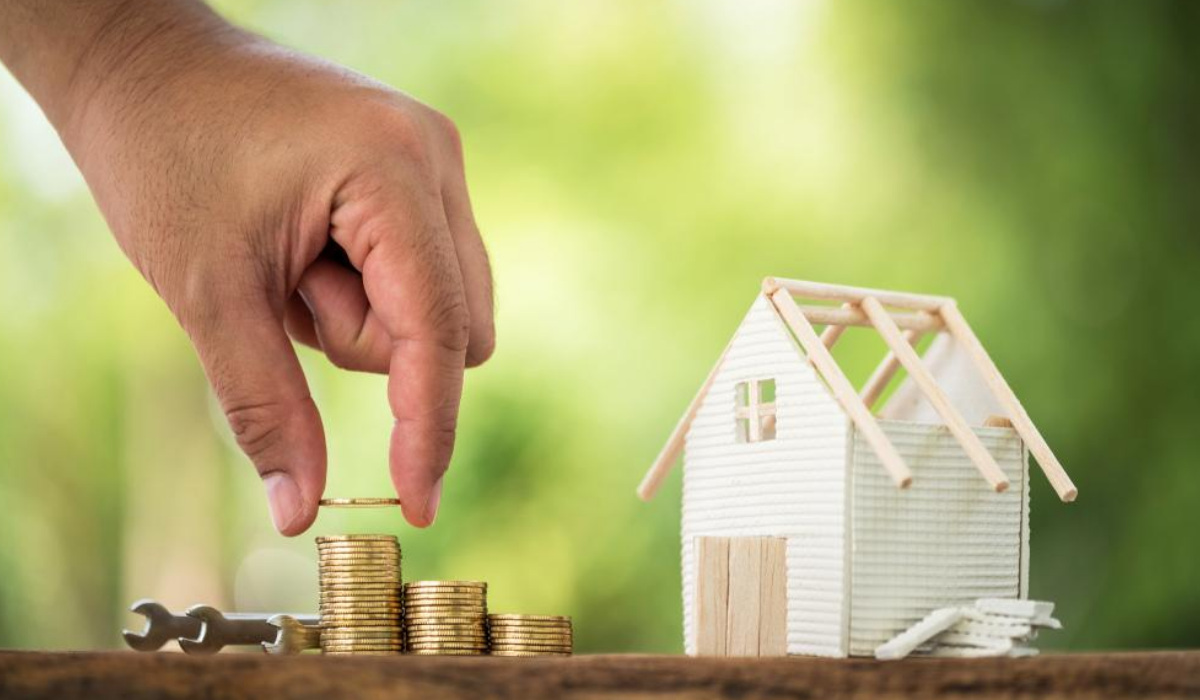Home>Home Maintenance>How To Get A Home Repair Loan


Home Maintenance
How To Get A Home Repair Loan
Modified: March 6, 2024
Looking for a home repair loan? Learn how to get a loan for your home maintenance needs with our expert tips and advice. Apply today!
(Many of the links in this article redirect to a specific reviewed product. Your purchase of these products through affiliate links helps to generate commission for Storables.com, at no extra cost. Learn more)
Introduction
Welcome to the world of home repairs! Whether you’re a homeowner or a renter, there’s no escaping the occasional need for maintenance and repairs in your humble abode. From leaky faucets to squeaky floors, keeping your home in tip-top shape is essential for comfort, safety, and preserving its value.
But what if you don’t have the funds readily available to cover the cost of repairs? That’s where a home repair loan can come to the rescue. In this article, we’ll dive into the world of home repair loans, exploring what they are, how they work, and how you can leverage them to tackle those dreaded repairs.
Home repair loans are financial products specifically designed to help homeowners or renters pay for necessary repairs and renovations. They provide a convenient solution for those who lack the financial means to cover the cost of repairs upfront. These loans typically have flexible terms and competitive interest rates, making them an attractive option for homeowners with pressing repair needs.
It’s important to note that home repair loans are distinct from traditional mortgages or home equity loans. While mortgages and home equity loans are used to finance the purchase of a property, home repair loans are specifically targeted at covering the cost of repairs or renovations after the purchase has been made.
With that in mind, let’s explore the different types of home repair loans available and how you can determine if you’re eligible to apply for one.
Key Takeaways:
- Home repair loans provide convenient funding for necessary repairs, offering flexibility, lower interest rates, and predictable payments. However, borrowers should carefully consider their financial situation and repayment obligations before taking on additional debt.
- Successful repayment of a home repair loan requires budgeting, timely payments, and exploring alternative options. By staying committed and focused, homeowners can effectively manage their loan and maintain their financial well-being.
Read more: Where To Get A Home Improvement Loan
Understanding Home Repair Loans
Home repair loans are a form of personal loan that can be used specifically for home repairs and renovations. These loans are typically unsecured, meaning you don’t need to provide collateral such as your home or car to secure the loan. The loan amount and terms will vary depending on the lender, your creditworthiness, and the scope of the repairs you need to undertake.
One of the key benefits of home repair loans is their flexibility. Unlike other financing options that may place restrictions on how the funds can be used, a home repair loan allows you to use the funds however you see fit for your repair or renovation project. Whether you need to fix a leaky roof, update your outdated kitchen, or repair a damaged foundation, a home repair loan can provide the financial means to make it happen.
Another advantage of home repair loans is that they often come with lower interest rates compared to credit cards or other forms of unsecured loans. This can result in significant savings over time, especially if you have a large repair project that requires substantial funding.
Home repair loans can be a lifesaver in emergencies when you don’t have the funds readily available to address necessary repairs. By securing a loan, you can address the repairs quickly and prevent further damage to your home, which could potentially cost you more in the long run.
It is important to note that while home repair loans can be a convenient solution for funding repairs, they do come with certain considerations. As with any loan, you will be responsible for repaying the borrowed amount plus interest and any associated fees. Therefore, it’s essential to have a clear repayment plan in place before taking out a home repair loan.
In the next section, we’ll explore the different types of home repair loans that you can consider based on your specific needs and circumstances.
Types of Home Repair Loans
When it comes to home repair loans, there are several options available to suit different needs and financial circumstances. Let’s take a look at some of the most common types:
- Personal Loans: Personal loans are a popular choice for home repairs as they provide a lump sum of money that can be used for any purpose. These loans are typically unsecured, meaning you don’t need to offer any collateral. Personal loans often have competitive interest rates and flexible repayment terms, making them a versatile option for various repair projects.
- Home Equity Loans: If you own a home and have built up equity, you may consider a home equity loan for your repair needs. With a home equity loan, you borrow against the value of your property. These loans usually have lower interest rates than personal loans, but your home serves as collateral, putting it at risk if you fail to repay the loan.
- Home Equity Line of Credit (HELOC): Similar to a home equity loan, a HELOC allows you to borrow against the equity in your home. However, rather than receiving a lump sum, you are given a line of credit that you can draw from as needed. This can be advantageous for ongoing home repair projects where expenses may vary over time.
- Government-Backed Loans: In certain cases, you may be eligible for government-backed loan programs specifically designed for home repairs. The Federal Housing Administration (FHA) offers a 203(k) loan program, which combines the purchase or refinance of a home with the cost of repairs and renovations. These loans often have favorable terms, but they may come with more stringent eligibility requirements.
- Energy-Efficiency Loans: If you’re planning to make energy-efficient upgrades to your home, such as installing solar panels or upgrading to energy-efficient windows, you may qualify for energy-efficiency loans. These loans often have lower interest rates and longer repayment terms, incentivizing homeowners to invest in environmentally friendly improvements.
Before choosing a home repair loan, it’s important to carefully consider your individual needs and financial situation. Take the time to assess the scope and cost of your repair project, as well as your ability to repay the loan. Additionally, review the eligibility requirements and terms of each loan option to determine the best fit for your circumstances.
Now that we’ve covered the types of home repair loans available, let’s explore the eligibility criteria you will need to meet to apply for a loan.
Eligibility Requirements
While the specific eligibility requirements for home repair loans can vary depending on the lender and the type of loan you’re applying for, there are some common criteria that you will typically need to meet. Here are the key factors that lenders consider when determining your eligibility:
- Credit Score: Your credit score plays a significant role in determining whether you qualify for a home repair loan. Lenders want to ensure that you have a history of responsible borrowing and are likely to repay the loan on time. While each lender may have different credit score requirements, a higher credit score generally improves your chances of approval and may result in more favorable loan terms.
- Income and Employment: Lenders will assess your income and employment stability to gauge your ability to repay the loan. You will typically need to provide proof of steady income, such as pay stubs or tax returns, and demonstrate that you have the financial means to cover the loan payments along with your other financial obligations.
- Debt-to-Income Ratio: Your debt-to-income ratio is a measure of your monthly debt payments compared to your income. Lenders use this ratio to assess your ability to manage additional debt. Generally, a lower debt-to-income ratio is preferred, as it indicates that you have enough income to comfortably handle loan repayments.
- Loan Amount: The amount of funding you need for your home repairs may impact your eligibility, as some lenders have minimum or maximum loan limits. Make sure the loan amount you’re seeking falls within the lender’s guidelines.
- Property Ownership or Rental Agreement: Depending on the type of loan you’re applying for, you may need to provide proof of ownership or a rental agreement for the property. This demonstrates that you have a vested interest in maintaining and improving the property.
- Other Requirements: Some lenders may have additional requirements, such as a minimum age, citizenship or residency status, and a clean criminal record.
It’s important to keep in mind that meeting the eligibility requirements doesn’t guarantee loan approval. Lenders will also consider other factors, such as your overall financial health and the purpose of the loan, when making their decision.
If you’re concerned about meeting the eligibility requirements for a home repair loan, there are steps you can take to improve your chances. These may include paying down outstanding debts, improving your credit score, and providing clear documentation of your income and employment stability.
Now that you understand the eligibility requirements for home repair loans, let’s move on to the next step – how to apply for a home repair loan.
How to Apply for a Home Repair Loan
Applying for a home repair loan is a straightforward process that typically involves the following steps:
- Evaluate Your Repair Needs: Start by determining the scope of your repair project and estimating the amount of funding you will need. This will help you narrow down your search for the most suitable loan option.
- Research Lenders: Once you have a clear idea of your funding needs, research lenders that offer home repair loans. Look for reputable lenders with competitive interest rates and favorable loan terms.
- Gather Documentation: Before applying for a loan, gather the necessary documentation to support your application. This may include proof of income, employment verification, recent bank statements, identification documents, and any other documents required by the lender.
- Submit Your Application: Complete the loan application form provided by the lender. Be thorough and accurate when filling out the application, ensuring that all information is up to date and correctly entered.
- Provide Supporting Documents: Along with the application, you will need to submit the required supporting documents. This may include income verification, proof of property ownership or rental agreement, and any additional documentation specified by the lender.
- Wait for Approval: After submitting your application and supporting documents, the lender will review your information and assess your eligibility. The approval process may take a few days to a few weeks, depending on the lender’s policies and workload.
- Loan Agreement and Terms: If your application is approved, the lender will provide you with a loan agreement that outlines the terms of the loan, including the loan amount, interest rate, repayment schedule, and any associated fees. Read the agreement carefully, and if you have any questions or concerns, don’t hesitate to seek clarification from the lender.
- Review and Sign: Once you’re satisfied with the loan agreement, sign it and return it to the lender. This is a legally binding contract, so make sure you understand and agree to all the terms and conditions before signing.
- Receive Funds: After signing the loan agreement, the lender will typically disburse the funds to you. Depending on the lender and the loan type, the funds may be transferred directly to your bank account or provided in another form, such as a check.
Throughout the application process, it’s important to stay organized and keep track of all the documentation and communication with the lender. Be prompt and responsive to any requests for additional information or clarification to ensure a smooth application process.
Now that you know how to apply for a home repair loan, let’s move on to the next step – finding the right lender.
Read more: How To Get A Loan To Do Home Improvements?
Finding the Right Lender
When it comes to obtaining a home repair loan, finding the right lender is crucial. The right lender will offer competitive rates, favorable loan terms, and excellent customer service. Here are some factors to consider in your search for the perfect lender:
- Research Different Lender Options: Start by researching different lenders that offer home repair loans. Look for lenders that specialize in home improvement loans or personal loans, as they have experience in funding repair and renovation projects.
- Compare Interest Rates: One of the most critical factors to consider is the interest rate offered by each lender. Lower interest rates can save you a significant amount of money over the life of the loan. Compare rates from different lenders and choose the one that offers the most competitive rate.
- Review Loan Terms: In addition to interest rates, review the loan terms offered by each lender. Consider factors such as the repayment period, any associated fees, and any penalties for early repayment. Ensure that the loan terms align with your financial situation and allow for comfortable repayment.
- Read Reviews and Testimonials: Take the time to read reviews and testimonials from previous customers. This will give you insights into the lender’s reputation, customer service, and overall satisfaction levels. Look for lenders with positive reviews and a track record of providing excellent service.
- Check Eligibility Requirements: Review the eligibility requirements of each potential lender to ensure that you meet their criteria. It’s also worth checking if the lender offers loans specifically tailored to your needs, such as energy-efficient loans or government-backed loan programs.
- Consider Personal Recommendations: Seek recommendations from friends, family, or colleagues who have obtained home repair loans in the past. They can provide valuable insights and recommendations based on their personal experiences.
- Customer Service: Evaluate the customer service offered by each lender. Consider factors such as responsiveness, willingness to answer questions, and overall professionalism. A lender with excellent customer service can make the loan process smoother and more enjoyable.
- Apply and Compare Loan Offers: Once you have narrowed down your options, apply for a home repair loan with a few different lenders. Compare the loan offers you receive, including the interest rate, loan terms, and any associated fees. This will ensure that you choose the lender that offers the best overall package for your needs.
- Seek Pre-Approval: If you’re uncertain about your eligibility or want to know your borrowing capacity, consider seeking pre-approval from lenders. Pre-approval gives you an idea of how much you can borrow and allows you to shop around for the best loan terms.
Taking the time to research and evaluate different lenders is an essential step in securing a home repair loan. By finding the right lender, you can ensure that you receive the necessary funds at favorable terms, making your repair project more manageable and affordable.
Now that you know how to find the right lender, let’s dive deeper into understanding loan terms and interest rates.
Consider applying for a home repair loan through a government program or a reputable financial institution. Make sure to have a clear plan for the repairs and a good credit score to increase your chances of approval.
Understanding Loan Terms and Interest Rates
When applying for a home repair loan, it’s essential to understand the loan terms and interest rates offered by the lender. These factors will determine the total cost of the loan and the amount you will need to repay over time. Here’s what you need to know:
Loan Terms: Loan terms refer to the length of time you have to repay the loan. Typically, home repair loans have repayment terms ranging from a few months to several years. Shorter loan terms may result in higher monthly payments but can save you money in interest payments over the life of the loan. Longer loan terms may offer lower monthly payments but can result in paying more in interest over time. Consider the loan term that best fits your financial situation and ability to repay the loan.
Interest Rates: The interest rate is the percentage of the loan amount that the lender charges for borrowing the money. It determines the cost of borrowing and influences the total amount you will repay over time. Interest rates can be fixed or variable. With a fixed-rate loan, the interest rate remains the same throughout the repayment period, providing stability and predictable payments. Variable-rate loans, on the other hand, have interest rates that can fluctuate based on market conditions, potentially resulting in changes to your monthly payments.
When comparing loan offers, pay close attention to the interest rates offered by different lenders. A slightly lower interest rate can translate into significant savings over the life of the loan. However, keep in mind that the interest rate offered to you will depend on factors such as your creditworthiness, income, and loan amount.
Additionally, it’s important to understand any fees or charges associated with the loan. These may include origination fees, application fees, prepayment penalties, and late payment fees. Be sure to review the loan agreement carefully and ask the lender about any fees you don’t understand.
By understanding the loan terms and interest rates, you can make an informed decision when selecting a home repair loan. Compare offers from different lenders, considering the total cost of the loan, the monthly payment amount, and the overall affordability of the loan based on your financial situation.
Now that we’ve covered loan terms and interest rates, let’s discuss the repayment options available for home repair loans.
Repayment Options
When taking out a home repair loan, understanding the available repayment options is crucial. Different lenders may offer various repayment plans to accommodate your financial needs and preferences. Here are some common repayment options for home repair loans:
- Fixed Monthly Payments: This is the most common repayment option, where you make equal monthly payments throughout the loan term. Each payment includes a portion of the principal amount borrowed and the accrued interest. Fixed monthly payments provide stability and make it easier to budget for your loan payments.
- Biweekly Payments: With biweekly payments, you make half of your monthly payment every two weeks. Since there are 52 weeks in a year, you end up making 26 biweekly payments, which is equivalent to making 13 monthly payments in a year. Biweekly payments can help you pay off the loan faster and save on interest over time.
- Interest-Only Payments: Some lenders may offer the option to make interest-only payments for a certain period, typically at the beginning of the loan term. During this period, you only pay the accrued interest on the loan, keeping the monthly payment lower. However, keep in mind that interest-only payments do not reduce the principal balance, and you will need to start making full principal and interest payments after the interest-only period ends.
- Flexible Payments: Some lenders provide flexibility in repayment by allowing you to make extra payments or increase your monthly payment amount without incurring prepayment penalties. This can help you pay off the loan faster and save on interest. Check with your lender to see if they offer flexible payment options.
- Automatic Payments: Many lenders offer the convenience of automatic payments, where your monthly payment is automatically deducted from your bank account. This can help ensure that you never miss a payment and may even qualify you for a lower interest rate.
- Early Repayment: If you have the financial means, consider repaying your home repair loan early. Paying off the loan before the agreed-upon term can save you money on interest payments. However, before making early repayments, check with your lender to ensure there are no prepayment penalties or fees.
Choosing the right repayment option depends on your financial goals and circumstances. Consider factors such as your monthly budget, cash flow, ability to make additional payments, and your overall loan repayment strategy.
Before finalizing your loan agreement, ensure that you fully understand the repayment terms and any associated fees or penalties. Discuss any questions or concerns you may have with your lender to ensure a clear understanding of your repayment obligations.
Now that we’ve covered repayment options, let’s take a look at the pros and cons of home repair loans.
Pros and Cons of Home Repair Loans
Home repair loans can be a valuable tool for homeowners and renters alike, providing the financial means to address necessary repairs. However, like any form of borrowing, there are pros and cons to consider. Let’s take a closer look at the advantages and disadvantages of home repair loans:
Pros:
- Convenient Funding: Home repair loans provide a convenient source of funding when you don’t have the cash readily available to cover necessary repairs.
- Flexible Use of Funds: Home repair loans allow you to use the funds for a variety of repair and renovation projects, giving you the flexibility to address your specific needs.
- Lower Interest Rates: Compared to credit cards or other forms of unsecured loans, home repair loans typically offer lower interest rates, saving you money over the life of the loan.
- Predictable Payments: With fixed interest rates and monthly payments, home repair loans provide predictability, making budgeting for your loan payments easier.
- Preserve Home Value: By addressing necessary repairs promptly, home repair loans help preserve the value of your home and prevent further damage, potentially saving you money in the long run.
- Flexible Repayment Options: Many lenders offer a range of repayment options, allowing you to choose a plan that suits your financial situation and goals.
Cons:
- Debt Obligation: Taking on a home repair loan means adding to your overall debt. Be sure to assess your ability to handle the loan payments alongside your existing financial obligations.
- Interest Costs: While home repair loans offer lower interest rates compared to some other forms of borrowing, you must still account for interest costs. Over time, the interest paid on the loan can increase the total cost of the repairs.
- Additional Fees: Some home repair loans may come with associated fees, such as origination fees or prepayment penalties. Be sure to review the loan agreement for any additional costs.
- Qualification Requirements: Qualifying for a home repair loan may require meeting certain eligibility criteria, such as having a good credit score and stable income. If you don’t meet these criteria, it may be challenging to secure a loan or obtain favorable terms.
- Repayment Obligation: Once you take on a home repair loan, you are responsible for repaying the borrowed amount plus interest. Ensure that you have a clear repayment plan in place to avoid any financial strain.
Considering the pros and cons of home repair loans will help you make an informed decision regarding your financing options. Assess your financial situation, repair needs, and ability to handle additional debt before committing to a loan.
Now that we’ve explored the pros and cons of home repair loans, let’s discuss some tips for successful loan repayment.
Tips for Successful Loan Repayment
Successfully repaying your home repair loan is essential to avoid financial strain and maintain a good credit history. Here are some tips to help you manage your loan repayments effectively:
- Create a Budget: Take the time to assess your monthly income and expenses to create a realistic budget. Allocate a specific amount for loan payments and ensure you can comfortably afford this expense.
- Make Timely Payments: Pay your loan installments on time to avoid late fees and potential damage to your credit score. Set up reminders or automatic payments to help you stay on track.
- Pay More than the Minimum: Whenever possible, consider paying more than the minimum required amount. Doing so can help you pay off the loan faster and reduce the total interest paid over time.
- Avoid Taking on Additional Debt: While repaying your home repair loan, try to avoid accumulating additional debt that can strain your finances. Minimize unnecessary expenses and focus on meeting your loan obligations.
- Stay in Communication with Your Lender: If you encounter financial difficulties or anticipate challenges in making payments, reach out to your lender. They may be able to offer alternative repayment options or assistance to help you stay on track.
- Use Windfalls for Loan Repayment: If you receive unexpected income, such as a bonus or tax refund, consider allocating a portion of it towards your loan repayment. This can help you make significant progress in paying off the loan.
- Refinance or Consolidate if Beneficial: If you find yourself struggling with multiple debts, consider refinancing or consolidating your loans. This can potentially lower your interest rates or help you manage your payments more effectively.
- Continue Home Maintenance: Regular home maintenance can help prevent major repairs down the line. By addressing minor issues promptly, you can avoid the need for expensive repairs and allocate more funds towards repaying your loan.
- Monitor Your Credit Score: Regularly monitor your credit score to ensure it remains in good standing. A strong credit score can help you secure better loan terms in the future and maintain your financial health.
- Stay Committed and Focused: Repaying a loan requires discipline and commitment. Stay focused on your financial goals, remind yourself of the benefits of being debt-free, and stay motivated throughout the repayment process.
Implementing these tips can help you stay on track with your loan repayments and ultimately pay off your home repair loan successfully. Remember, the key is to create a realistic budget, make timely payments, and actively manage your finances.
Now that we’ve discussed tips for successful loan repayment, let’s explore some alternative options to home repair loans.
Alternatives to Home Repair Loans
If a home repair loan doesn’t seem like the right fit for your situation, there are alternative options to consider. These alternatives can help you address your home repair needs without taking on additional debt. Here are a few alternatives worth exploring:
- Savings: If you have a sufficient amount of savings set aside, consider using those funds to cover the cost of your repairs. This eliminates the need to borrow money and incur interest charges.
- Homeowners Insurance: Review your homeowners insurance policy to determine if the repairs you need are covered. Certain types of damage, such as those caused by natural disasters or accidents, may be eligible for insurance coverage.
- Government Assistance Programs: Research government assistance programs that provide financial support for home repairs. These programs may be available at the federal, state, or local levels and may provide grants, loans, or subsidies for eligible homeowners.
- Charitable Organizations: Some charitable organizations offer assistance to homeowners in need of repairs, particularly for those with limited financial resources or who are facing difficult circumstances. Explore local nonprofit organizations or foundations that may be able to provide support.
- DIY or Bartering: If you’re skilled or have friends or family members with the necessary expertise, consider tackling the repairs yourself or exchanging services. This can help save on labor costs, making the repairs more affordable.
- Payment Plans with Contractors: Talk to contractors or repair professionals about the possibility of setting up a payment plan. They may be willing to work with you to spread out the cost of the repairs over time.
- Government Loans: In addition to home repair loans, government agencies, such as the Small Business Administration (SBA), offer loans for eligible homeowners and renters to repair or rebuild their homes following a disaster.
- Home Equity Lines of Credit (HELOCs): If you have built up equity in your home, a HELOC may be an option to consider. This allows you to borrow against the value of your home and use the funds for repairs. However, beware that using a HELOC puts your home at risk if you fail to repay the loan.
Exploring these alternatives can help you find a solution that aligns with your financial situation and repair needs. Remember to carefully weigh the advantages and disadvantages of each option and choose the one that best suits your circumstances.
Now that we’ve covered alternative options to home repair loans, let’s wrap up our discussion.
Conclusion
In conclusion, home repair loans can be a valuable tool for homeowners and renters who need financial assistance to address necessary repairs and renovations. These loans provide a convenient source of funding and can help you preserve the value of your home while ensuring comfort, safety, and functionality.
Before applying for a home repair loan, it’s important to understand the different types of loans available, such as personal loans and home equity loans, and evaluate your eligibility based on factors like credit score, income, and property ownership.
When choosing a lender, take the time to research and compare options to find the one that offers competitive interest rates, favorable loan terms, and excellent customer service. Understanding the loan terms, repayment options, and associated fees will help you make informed decisions and manage your loan effectively.
While home repair loans provide financial support, it’s crucial to consider the pros and cons and assess your ability to handle the additional debt. Creating a budget, making timely payments, and exploring alternative options like using savings or seeking assistance from government programs can help you avoid financial strain.
Remember, successfully repaying your home repair loan is within reach with careful planning, responsible budgeting, and staying committed to your financial goals.
In the end, implementing the tips provided and exploring alternative options when necessary can ensure a successful home repair journey while maintaining your financial well-being.
So, whether you choose a home repair loan or explore other avenues, don’t delay those necessary repairs. Take the necessary steps to keep your home in tip-top shape and enjoy a safe, comfortable, and beautiful living space.
Frequently Asked Questions about How To Get A Home Repair Loan
Was this page helpful?
At Storables.com, we guarantee accurate and reliable information. Our content, validated by Expert Board Contributors, is crafted following stringent Editorial Policies. We're committed to providing you with well-researched, expert-backed insights for all your informational needs.













